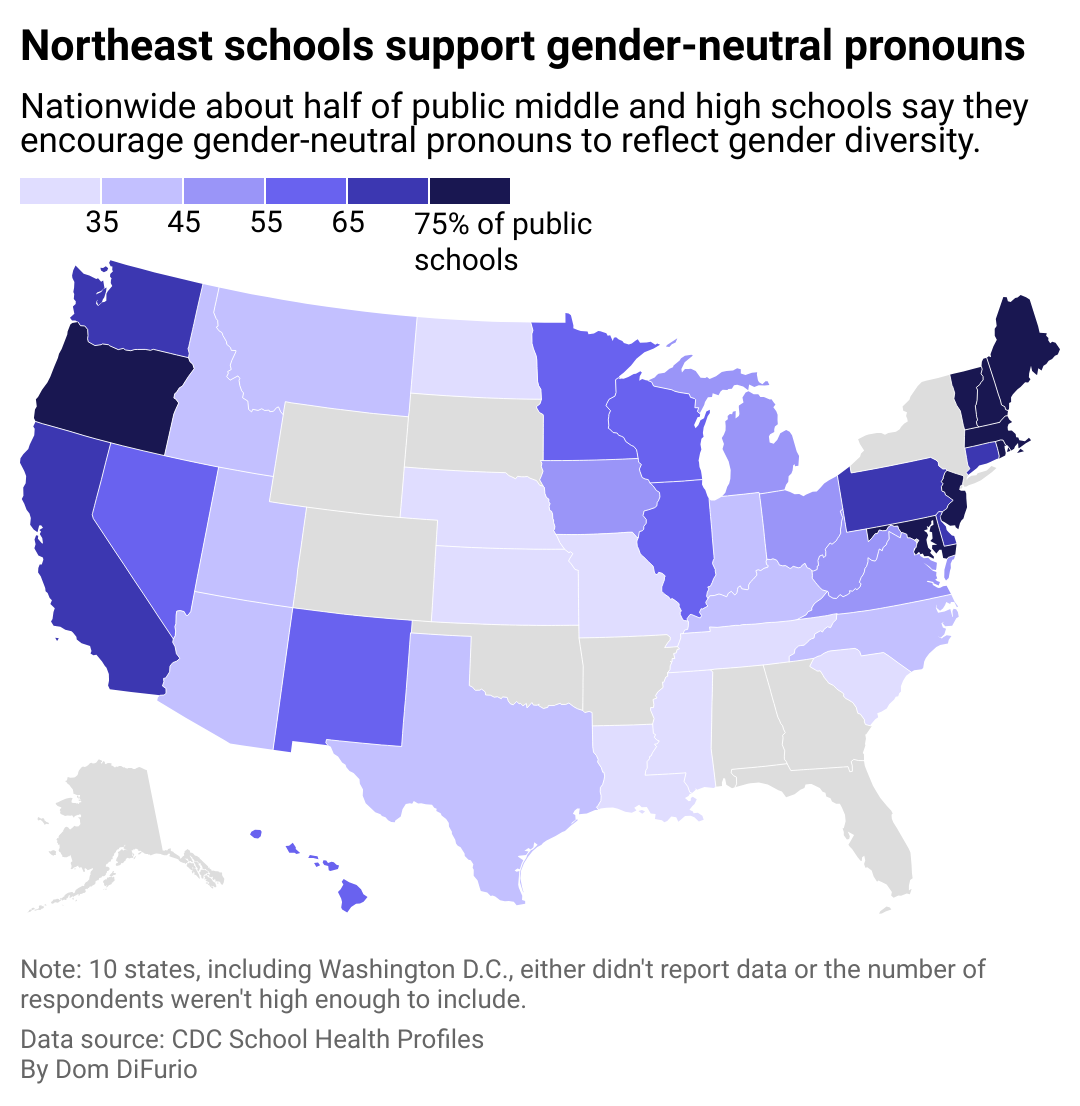“There’s always the fear of unacceptance and confusion, but your pronouns are a right that can never be taken away,” agender student Cruz told GLSEN, an education organization that supports safe and LGBTQ+ inclusive schools. “It is very anxiety-inducing to say, ‘Actually, my pronouns are … and it is appreciated that you use them.'”
Schools can be inclusive of transgender and nonbinary students and support them in initiating that conversation with peers and teachers, however, not all schools do, according to the Centers for Disease Control and Prevention 2022 school profile data. The data released in March 2024 shows that the state a child lives in can impact whether or not they feel welcome at school—a dynamic with potentially deadly consequences for LGBTQ+ youth.
Counseling Schools analyzed CDC data on public school inclusion strategies to illustrate the prevalence of support for acknowledging the students’ pronouns during sexual health instruction in the United States.
The agency’s survey data shows that half of U.S. public schools are actively encouraging teachers and staff to implement inclusive practices in sexual health education, such as the use of gender-neutral pronouns, where appropriate, to recognize and accommodate for gender diversity in the student population. LGBTQ+ youth are increasingly diverse and include members of the nonbinary and trans community who sometimes use they/them pronouns, a combination of gendered and gender-neutral pronouns, or the pronoun that better reflects their true gender.
Research has shown that correctly using a person’s pronouns has a critical impact on the mental health and well-being of LGBTQ+ youth. Pronouns are a public health issue, according to a study published in the American Journal of Public Health, so much so that gender identity should be seen as a social determinant of mental health in a person’s life.
LGBTQ+ youth are already at elevated risk of suicide compared to their straight and cisgender peers, but even more for those whose gender identity does not match the sex they were assigned at birth or does not fit neatly into one of two male/female binary genders. Nearly half of all transgender and nonbinary youth have seriously considered attempting suicide, according to the Trevor Project 2024 U.S. National Survey on the Mental Health of LGBTQ+ Young People, which also indicated that 1 in 2 students found their school to be gender-affirming and thus reported lower rates of attempting suicide.
How schools approach the mental well-being of nonbinary and transgender students can have a significant impact on their educational futures as well as their physical safety. In Katy, Texas, for example, policies that require staff to notify parents when students use a different pronoun or identify as a different gender have pushed many to drop out of school.
“When someone’s telling you every day that you aren’t who you say you are, you start to question yourself. You start to believe the things that they tell you, that you’re inherently a bad person because you were born a certain way,” 17-year-old Kadence Carter, who left Mayde Creek High, told Houston Landing.
In Oklahoma, where students have been banned from using bathrooms that match their gender identity, 16-year-old Nex Benedict, a nonbinary student, died the day after they were bullied and beaten in the bathroom by peers at school. His death was ruled a suicide after a medical examiner’s report revealed a “combined toxicity” of an antihistamine and a drug often used to treat depression. Benedict used both they/them and he/him pronouns, according to interviews by NPR staff.
The data from the CDC’s 2022 Lead Health Education Teacher Surveys reveals a large gap in how schools in different states have taken a role in encouraging gender inclusivity. It comes after the COVID-19 pandemic left transgender and nonbinary students isolated and without access to resources like mental health counseling and gender-affirming care, which contributed to worsening mental health conditions.

A handful of states educate broadly on pronouns in requisite sexual education courses
Schools in Northeastern states—including Vermont, Massachusetts, Maryland, Rhode Island, and New Jersey—reported the highest rates of encouraging the use of gender-neutral pronouns where appropriate.
Schools in the South and Midwest are less likely to encourage staff and teachers to use gender-neutral pronouns, and in a number of cases did not report data about health education to the CDC at all.
Many of the states where fewer than half of schools report encouraging appropriate pronoun use are those where Republican officials hold higher office. The party has been particularly aggressive in passing anti-trans laws aimed at restricting the rights of LGBTQ+ people in recent years. Florida, for example, has passed legislation that would censor teachers from classroom discussions on gender identity or sexual orientation from pre-K through 8th grade and prohibit gender-inclusive bathrooms and changing areas in public buildings.
Some school districts have proposed or enacted policies to ban teachers from referring to students by the pronouns they use. Some school districts in Texas, Indiana, North Dakota, and Utah have begun to require schools to notify parents when a student requests to use different pronouns at school. Florida has gone even further, enacting legislation to allow educators to disregard a student’s pronouns and forbid the teachers themselves from using those pronouns, a ban blocked in April 2024 by a federal judge for being in violation of free speech rights. According to the Movement Advancement Project, since 2020, eight states (including Iowa and Idaho) have state laws now that explicitly require staff to out transgender youth to their families.
These laws have created a problematic dynamic for teachers. “It really puts teachers in a bind,” Nick Archuleta, a former high school teacher in North Dakota, told Education Week. “We all know that good education is predicated on good relationships. We want students to be able to trust their teachers. We want students to be able to talk to their teachers or counselors about things that may be problematic for them at home.”
California, in contrast, passed its own law to protect students’ requests to prevent notifying parents about their gender identity and the pronouns they use in an effort to protect the children from households where their identities may not be welcome. The state has one of the highest rates in the country of schools that encourage implementing inclusive practices in sex health education by recognizing gender-neutral pronouns at 74% of schools.
Although gender-neutral pronouns have become an easy target for anti-trans legislation, there are encouraging signs in CDC surveys that gender inclusivity is discussed more broadly outside of formal instruction. A far greater percentage of states—almost 80%—reported they do broadly encourage students to respect others’ sexual orientation and gender identity.
“This is not anyone trying to usurp parental rights,” Archuleta told Education Week. “It is about trying to create an environment where a child feels safe and trusted and trusting so that they have the best opportunity to learn.”
Story editing by Carren Jao. Additional editing by Kelly Glass. Copy editing by Sofia Jarrin. This story originally appeared on Sechel Ventures and was produced and
distributed in partnership with Stacker Studio.
Follow Metro Parent on Instagram.
from Metro Parent https://ift.tt/1bNVzY9










0 comments:
Post a Comment